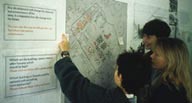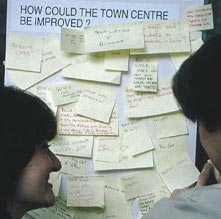Community Planning: Methods
Interactive display
- description
- more detail
- more pictures
Interactive displays allow people to engage in the issues and debate, on their own and in an enjoyable way, by making additions or alterations to pre-prepared exhibits.
Interactive displays can be used as part of a forum, workshop, exhibition, conference or other event
The displays can range from blank sheets with simple one-line questions to drawings or models of complex development proposals.
A dynamic develops as people's comments build up on the displays over time.
Thoughtful design is required to ensure that the information is presented simply and clearly and that people's responses are recorded in such a way that they can be used afterwards.
Photocredits
top: East Street, Farnham, UK, 1997, Nick Wates.,
bottom: Bath, UK, 1997, Nick Wates
top: East Street, Farnham, UK, 1997, Nick Wates.,
bottom: Bath, UK, 1997, Nick Wates

Sticky dot display
Voting for liked and disliked buildings and spaces.

Post-it board
Comments build up in response to a simple question.
Tips
- Have facilitators on hand to help people get going. Once responses start to build up, the process develops its own momentum.
- Shop front or on-the-street venues work well as people are attracted by others taking part (see also Street Stall).
- Photograph displays or use other ways or recording them before dismantling them.
Costs
- Main costs: artwork and materials. Simple displays can be designed and prepared within a few minutes and need little equipment. Employing graphic or exhibition designers improves effectiveness immensely, particularly for getting responses to complex design ideas but will normally cost a considerable amount in fees.
Post-it board ideas
Headings for four blank boards which people can stick Post-it notes on (or use scraps of paper and drawing pins):
Headings for four blank boards which people can stick Post-it notes on (or use scraps of paper and drawing pins):
- What do you LIKE about the area?
- What do you DISLIKE about the area?
- What IMPROVEMENTS could be made?
- What can YOU do to help?
Interactive display ideas
- Verbal likes, dislikes and ideas
Put up large sheets of blank paper with suitable headings (see box, left) and get people to put their responses on Post-its. - Visual likes, dislikes and ideas
Ask people to mark their most and least favourite buildings and spaces on maps or photos using Post-its or sticky dots. - Comments on proposals
Get people's views on development proposals or options by placing sticky dots or Post-its on prepared cards linked to plans or drawings.
(also seeTable scheme display). - General thoughts
Use flipcharts or comment books to get general comments.

Tools for participation
Post-it notes, sticky dots (several colours), coloured felt-tip pens and ballpoint pens.

Flip chart comment sheet
More visible than a book.

Cumulative comments
Adding points to those typed up from a workshop.
Photocredits
East Street, Farnham, UK, 1997, Nick Wates.,
East Street, Farnham, UK, 1997, Nick Wates.,